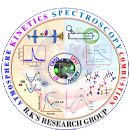Innumerable varieties of the chemical compounds are released into the Earth's atmosphere via natural, anthropogenic and biogenic emissions. These compounds show adverse effects such as influence on the climate, eco system and human health directly or indirectly. One such adverse effects is the well known Antarctic ozone hole formation because of the chlorofluorocarbons (CFCs). This has lifted the eyebrows of the scientific community and the search for alternatives was initiated after the CFC were banned at the Montreal protocol. Therefore, it is very essential to understand the fate of each compound in the Earth's atmosphere before their usage in any form. In our research laboratory, efforts for such an understanding on many compounds that are being released into the Earth's atmosphere are initiated. The compounds of our interest include starting from the alternatives compounds to CFCs till the recent bio-fuels and their additives. Although many physical and chemical properties are needed to be explored, we measure the kinetic parameters of the reactions of these compounds with the oxidizing agents as a first step.
Research Interests
Spectroscopy and Atmospheric Chemical Kinetics

All the compounds those are released into the Earth's atmosphere, undergo either physical or chemical processes. The physical processes include absorption of light and thus initiated photochemical processes. The chemical processes include the reaction of these compounds with abundant oxidising species to form transient species and thereby contribute significantly to the chemical composition of the Earth's atmosphere. To understand the complete fate of a molecule that is released into the Earth's atmosphere, the research work carried out in our laboratory is broadly categorized into two domains accordingly.
Spectroscopy
The absorption of light at a suitable wavelength by a molecule leads to the photodissociation into several radicals or transient species. Therefore, the quantum yields, absorption cross-section of the formed radicals and their loss processes via chemical reactions are needed to be studied to have a complete picture of any molecules of importance in the atmosphere. To achieve this goal, a state of the art instrument called "Cavity Ring-Down Spectrometer (CRDS)" has been built in our laboratory. In simple words, a photon is trapped in a highly reflective optical cavity and it is allowed to travel between them to enhance its optical path length.
About 20-50 km optical path length is just very trial to be achieved using this technique. This very high optical path length makes the technique super sensitive and will enable to detect trace gasses even when the concentrations are as low as ppb. Using the CRDS, one can measure- (i) The absorption cross sections of any transient species or radical; (ii) Quantum yield of formation of such a radical & also the (iii) Kinetics of radical-radical,radical-molecular reactions. All these studies are being presently carried out in our laboratory.

The inbuilt pulsed laser photolysis Cavity Ring Down Spectrometer (PLP-CRDS) in our old lab. The photolsis and probe beam arms of the PLP-CRDS setup are perpendicular to each other.

The experimentally measured absorption spectrum of o-xylyl radical at (298 ± 2) K in the wavelength range of 460.1–475.1 nm with 0.2 nm resolution. The absorption maximum was observed at 468.3 nm and the vertical bars represent errors in 2σ. [Bej et al., Chem. Phys. Lett. 2021, 765, 138314]
Atmospheric Chemical Kinetics
The lifetime of any compound released into the Earth's atmosphere depends on the rates of their reactions with the oxidizing species such as hydroxyl radicals (OH), Cl atoms, NO3 radicals etc. The lifetimes of the compounds can be estimated using the measured kinetic parameters in the temperatures relevant to the atmospheric conditions. We adopt two methods namely relative rate (RR) method and Pulsed Laser Photolysis - Laser Induced Fluorescence (PLP-LIF) method, for the purpose of these measurements. In the RR method, the rate kinetic parameters are measured relative to a known reaction. The PLP-LIF method is an absolute method, wherein the concentration of one of the species is measured using an induced fluorescence. The kinetic parameters are obtained using the measured temporal profile of that species.

The designed PLP-LIF cell to carry out the absolute rate measurements

An in-built crossed pulsed laser photolysis Cavity Ring-Down Spectroscopy (CRDS) reaction cell in our laboratory

Collinear Photolysis Cavity Ring-Down Spectroscopy (CoP-CRDS)

New in-built colinear PLP-CRDS setup which will enhance the detection sensitivity due to its increased length of effective absorption. The angle between the photolysis and probe beam arms of the reaction cell has been kept ~45 degrees.

Schematic representation of the pulsed laser photolysis-laser induced fluorescence (PLP-LIF) setup in our laboratory of atmospheric processes at the department of Chemistry of IIT Madras. DAQ: Data Acquisition Card; MFC: Mass Flow Controllers.

Left to Right (over optical table): Nd:YAG pumped dye laser; colinear PLP-CRDS setup; 248 nm KrF excimer laser (ns, pulsed). Right down corner: PLP-LIF setup. Farthest corner top right: GC-MS, GC-IR instruments. Top (hanging over optical table): calibrated mass flow controllers. The optical table also accommodates baratron pressure gauges, gas mixing chamber, photo-multiplier tube (PMT), box-car integrator, optical mounts for alignment purpose, delay generators etc. The complete gas handling system can also be seen in this picture.


Cross Photolysis Cavity Ring-Down Spectroscopy (CP-CRDS)


